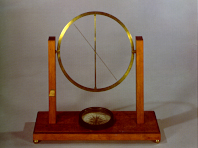
33.5 x 11.9 x 34.9
Steel, paper, wood and brass
INDEX 1788 : M.III.55
Machina Leotaudi ad observandam Inclinationem Acus Magneticae.
A Leotaud machine for observing the dip of a magnetic needle.
This instrument consists of two compasses mounted on the same support, whose purpose is the study of the declination and dip of a magnetic field. It was devised by the Jesuit, Vincent Léotaud (1596-1672) in his Magnetologia, 1668.
The declination compass is mounted on a circular engraving representing a compass with 32 points; North is indicated by a fleur-de-lis. The engraving is in a 10 cm diameter box with a glass top. The box is set in a horizontal wooden base. Two wooden shafts are fixed in the base and these hold a round brass ring with two scales on opposite quadrants, relative to its centre. This ring has a vertical axis divided into two equal sections; a second, magnetic, needle is attached to its mid point, and this is displaced on the vertical plane of the ring. The angle formed by the magnetic needle with the horizontal is read on the scale engraved in the disc and indicates the dip of the earth's magnetic field in a given place.
Sigaud de la Fond, Joseph-Aignan, Description et Usage d'un Cabinet de Physique Expérimentale, Paris, 1775, Vol. II, Pl. XXVIII.